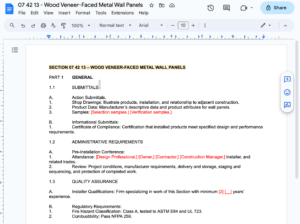Simplified
If you’re new to the world of construction, you might find yourself feeling lost in a sea of unfamiliar terms and technical jargon. Unlike residential projects, commercial construction comes with its own unique language, where project specifications are consistently referred to by MasterFromat, divisions, sections, and titles. The terminology remains consistent across states and sites, but this wasn’t always the case.
In the early 20th century, communication about construction specifications was a chaotic mess. Each state had its own way of organizing and presenting information. For example, a California project might specify concrete in Section 8A, while a similar project in Texas would define the same scope in Section 32. This inconsistency made it difficult for tradespeople to locate information, leading to confusion and inefficiency throughout the construction industry.
The Birth of Standardization: Emerges
The turning point came in 1947 when a group of engineers from various U.S. government agencies convened an informal think tank. Their mission was clear: to tackle the challenge of standardizing information, improving communication among all parties involved in construction, and establishing a uniform specification system. Little did they know that their efforts would lead to the creation of the Construction Specifications Institute (CSI).
Following World War II, this think tank evolved into what we now know as the Construction Specifications Institute, established officially in 1948. became an industry-wide organization with a primary goal: to advance specifications by developing a numbering system and a systematic approach to organizing construction documents, all while standardizing forms used in the industry.
The Birth of Construction Specifications Institute
In 1963, the Construction Specifications Institute introduced the Format for Construction Specifications. This groundbreaking system featured a numbering scheme with titles for organizing construction information into significant work divisions. The initial release consisted of 16 divisions, each further subdivided into several sections, all managed by a five-digit numbering sequence and corresponding title. It was a standard way of organizing information that could be consistently applied from one project to another.
For example, Division 9 was dedicated to “Finishes,” and under that division, you could find Section 09650 for “Resilient Flooring.” This structured approach streamlined the construction industry’s information management.
From Format to MasterFormat: A Name Change
In 1978, the format we had come to know as the “CSI Format for Construction Specifications” adopted a new name: MasterFormat. This change marked a significant moment in the history of construction documentation. MasterFormat not only streamlined communication but also improved information retrieval and standardized the way specifications were presented across commercial construction projects.
CSI MasterFormat: The Dewey Decimal System for Construction
Today, many in the industry affectionately refer to MasterFormat as the “Dewey Decimal System” for organizing products and assemblies in the construction world. It serves as the backbone of the industry, promoting standardization and facilitating communication among all parties involved in commercial construction projects.
The Current Structure: Divisions
In 2004, MasterFormat underwent another transformation, expanding from 16 divisions to 50 divisions. Each section was upgraded from a five-digit to a six-digit numbering system, accompanied by a corresponding title. This expansion allowed to adequately cover a broader range of construction industry subject matter while providing additional space for more specific topics at each classification level.
The expansion was a necessity because the older MasterFormat from 1995, with its 16 divisions, simply couldn’t keep up with the industry’s growth. It had run out of space to adequately address the ever-evolving subjects related to construction, leading to inconsistent classification of information.
The Power of Six-Digit Sections
The six-digit section numbers are structured in three sets of paired numbers, one pair per level. This structure allows for greater subdivisions at each level, making it easier to categorize and locate information. This expanded six-digit section numbering system and corresponding titles significantly enhance the retrieval of information and improve communication among all parties involved in designing and constructing commercial and industrial construction projects.
Let’s break it down with an example:
- 07 50 00 – Membrane Roofing
- 07 51 00 – Built-Up Bituminous Roofing (Level 2)
- 07 51 13 – Built-Up Asphalt Roofing (Level 3)
- 07 51 13.13 – Cold-Applied Built-Up Asphalt Roofing (Level 4)
Each level provides more specific information about the subject matter, allowing for precise identification and retrieval of relevant details.
Six-digit construction specifications are in action at this link.
Adapting to an Evolving Industry
In the ever-changing landscape of construction, products evolve, and innovations are constantly introduced. To stay relevant, updates its structure every two years. Today, it boasts a staggering 7,300 sections, each meticulously crafted to cover the diverse needs of the industry.
This adaptability allows for a tailored approach to specifying construction requirements for each unique project.
Staying Current: The 2016 Edition and Beyond
The most recent edition of MasterFormat is the 2016 edition, available for download. It incorporates changes and enhancements made for the 2018 edition, replacing all previous updates. Produced collaboratively by the Construction Specifications Institute (CSI) and Construction Specifications Canada (CSC), this edition reflects the ongoing commitment to enhancing and refining the system to meet the industry’s evolving needs.
2018 MasterFormat Download
MasterFormat Revisions by Year
A Deep Dive into the 50 Divisions of
To give you a comprehensive overview of the extensive coverage provided by CSI , here’s a breakdown of the 50 divisions:
PROCUREMENT AND CONTRACTING REQUIREMENTS GROUP
- Division 00 — Procurement and Contracting Requirements
SPECIFICATIONS GROUP
General Requirements Subgroup
- Division 01 — General Requirements
Facility Construction Subgroup
- Division 02 — Existing Conditions
- Division 03 — Concrete
- Division 04 — Masonry
- Division 05 — Metals
- Division 06 — Wood, Plastics, and Composites
- Division 07 — Thermal and Moisture Protection
- Division 08 — Openings
- Division 09 — Finishes
- Division 10 — Specialties
- Division 11 — Equipment
- Division 12 — Furnishings
- Division 13 — Special Construction
- Division 14 — Conveying Equipment
Facility Services Subgroup
- Division 21 — Fire Suppression
- Division 22 — Plumbing
- Division 23 — Heating, Ventilating, and Air Conditioning (HVAC)
- Division 25 — Integrated Automation
- Division 26 — Electrical
- Division 27 — Communications
- Division 28 — Electronic Safety and Security
Site and Infrastructure Subgroup
- Division 31 — Earthwork
- Division 32 — Exterior Improvements
- Division 33 — Utilities
- Division 34 — Transportation
- Division 35 — Waterway and Marine Construction
Process Equipment Subgroup
- Division 40 — Process Interconnections
- Division 41 — Material Processing and Handling Equipment
- Division 42 — Process Heating, Cooling, and Drying Equipment
- Division 43 — Process Gas and Liquid Handling, Purification, and Storage Equipment
- Division 44 — Pollution and Waste Control Equipment
- Division 45 — Industry-Specific Manufacturing Equipment
- Division 46 — Water and Wastewater Equipment
- Division 48 — Electrical Power Generation
Unlocking the Language of Commercial Construction
In conclusion, stands as a cornerstone of the construction industry, revolutionizing how information is communicated, organized, and standardized in commercial construction. With its 50 divisions and thousands of sections, it offers a comprehensive framework that adapts to the ever-evolving needs of the industry.
Whether you’re new to construction or a seasoned professional, understanding is essential for success in commercial construction projects. It not only streamlines communication but also ensures that all parties involved are on the same page, contributing to efficient and successful project outcomes.
As the construction industry continues to advance, evolves alongside it, staying current and adaptable. The 2016 edition, available for download, reflects the commitment to enhancing the system to meet the industry’s needs. So, whether you’re a specifier, architect, contractor, or supplier, mastering the language of is your key to unlocking success in the complex world of commercial construction.



